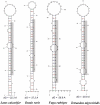Identification and characterization of 63 MicroRNAs in the Asian seabass Lates calcarifer
- PMID: 21412421
- PMCID: PMC3055879
- DOI: 10.1371/journal.pone.0017537
Identification and characterization of 63 MicroRNAs in the Asian seabass Lates calcarifer
Abstract
Background: MicroRNAs (miRNAs) play an important role in the regulation of many fundamental biological processes. So far miRNAs have been only identified in a few fish species, although there are over 30,000 fish species living under different environmental conditions on the earth. Here, we described an approach to identify conserved miRNAs and characterized their expression patterns in different tissues for the first time in a food fish species Asian seabass (Lates calcarifer).
Methodology/principal findings: By combining a bioinformatics analysis with an approach of homolog-based PCR amplification and sequencing, 63 novel miRNAs belonging to 29 conserved miRNA families were identified. Of which, 59 miRNAs were conserved across 10-86 species (E value ≤ 10⁻⁴) and 4 miRNAs were conserved only in fish species. qRT-PCR analysis showed that miR-29, miR-103, miR-125 and several let-7 family members were strongly and ubiquitously expressed in all tissues tested. Interestingly, miR-1, miR-21, miR-183, miR-184 and miR-192 showed highly conserved tissue-specific expression patterns. Exposure of the Asian seabass to lipopolysaccharide (LPS) resulted in up-regulation of over 50% of the identified miRNAs in spleen suggesting the importance of the miRNAs in acute inflammatory immune responses.
Conclusions/significance: The approach used in this study is highly effective for identification of conserved miRNAs. The identification of 63 miRNAs and determination of the spatial expression patterns of these miRNAs are valuable resources for further studies on post-transcriptional gene regulation in Asian seabass and other fish species. Further identification of the target genes of these miRNAs would shed new light on their regulatory roles of microRNAs in fish.
Conflict of interest statement
Figures





Similar articles
-
Identification and characterization of novel and conserved microRNAs in several tissues of the Chinese rare minnow (Gobiocypris rarus) based on illumina deep sequencing technology.BMC Genomics. 2016 Apr 12;17:283. doi: 10.1186/s12864-016-2606-5. BMC Genomics. 2016. PMID: 27066897 Free PMC article.
-
Discovery and characterization of miRNA genes in Atlantic salmon (Salmo salar) by use of a deep sequencing approach.BMC Genomics. 2013 Jul 17;14:482. doi: 10.1186/1471-2164-14-482. BMC Genomics. 2013. PMID: 23865519 Free PMC article.
-
Circulating MicroRNAs Indicative of Sex and Stress in the European Seabass (Dicentrarchus labrax): Toward the Identification of New Biomarkers.Mar Biotechnol (NY). 2023 Oct;25(5):749-762. doi: 10.1007/s10126-023-10237-0. Epub 2023 Aug 15. Mar Biotechnol (NY). 2023. PMID: 37581865
-
Circulating miRNAs involved in the immune response of the European seabass (Dicentrarchus labrax).Fish Shellfish Immunol. 2025 May;160:110232. doi: 10.1016/j.fsi.2025.110232. Epub 2025 Feb 24. Fish Shellfish Immunol. 2025. PMID: 40010615 Review.
-
miRNAs associated with immune response in teleost fish.Dev Comp Immunol. 2017 Oct;75:77-85. doi: 10.1016/j.dci.2017.02.023. Epub 2017 Feb 28. Dev Comp Immunol. 2017. PMID: 28254620 Review.
Cited by
-
Characterization of miRNAs in Embryonic, Larval, and Adult Lumpfish Provides a Reference miRNAome for Cyclopterus lumpus.Biology (Basel). 2022 Jan 13;11(1):130. doi: 10.3390/biology11010130. Biology (Basel). 2022. PMID: 35053128 Free PMC article.
-
Temperature during early development has long-term effects on microRNA expression in Atlantic cod.BMC Genomics. 2015 Apr 17;16(1):305. doi: 10.1186/s12864-015-1503-7. BMC Genomics. 2015. PMID: 25881242 Free PMC article.
-
Molecular Mechanisms Regulating Muscle Plasticity in Fish.Animals (Basel). 2020 Dec 30;11(1):61. doi: 10.3390/ani11010061. Animals (Basel). 2020. PMID: 33396941 Free PMC article. Review.
-
In vivo screening of zebrafish microRNA responses to bacterial infection and their possible roles in regulating immune response genes after lipopolysaccharide stimulation.Fish Physiol Biochem. 2012 Oct;38(5):1299-310. doi: 10.1007/s10695-012-9617-1. Epub 2012 Mar 15. Fish Physiol Biochem. 2012. PMID: 22419229
-
MicroRNA in teleost fish.Genome Biol Evol. 2014 Jul 22;6(8):1911-37. doi: 10.1093/gbe/evu151. Genome Biol Evol. 2014. PMID: 25053657 Free PMC article. Review.
References
-
- Lee RC, Feinbaum RL, Ambros V. The C. elegans heterochronic gene lin-4 encodes small RNAs with antisense complementarity to lin-14. Cell. 1993;75:843–854. - PubMed
-
- Jia W, Li Z, Lun Z. Discoveries and functions of virus-encoded MicroRNAs. Chinese Science Bulletin. 2008;53:169–177.
-
- Kim VN, Nam JW. Genomics of microRNA. TRENDS in Genetics. 2006;22:165–173. - PubMed
-
- Zhao Y, Samal E, Srivastava D. Serum response factor regulates a muscle-specific microRNA that targets Hand2 during cardiogenesis. Nature. 2005;436:214–220. - PubMed
Publication types
MeSH terms
Substances
LinkOut - more resources
Full Text Sources

